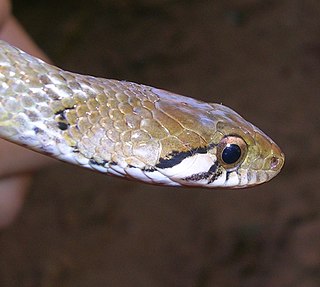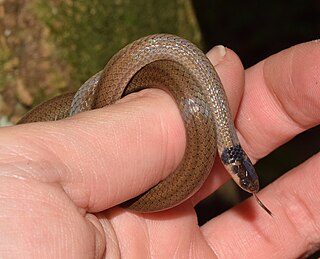
The Nilgiri keelback, also known commonly as Beddome's keelback, is a species of snake found in the Western Ghats in India. The species is named after Richard Henry Beddome, 1830–1911, British army officer and naturalist. It was first discovered near the Nilgiris but is now known more widely from the Western Ghats. This snake is terrestrial and feeds on toads.

Hydrophis melanocephalus, commonly known as the slender-necked sea snake, is a species of venomous sea snake in the family Elapidae.
Aparallactus lineatus, or the lined centipede-eater, is a species of mildly venomous rear-fanged snake in the family Atractaspididae.
Aparallactus niger is a species of mildly venomous rear-fanged snake in the family Atractaspididae. It is endemic to Western Africa.
Micrelaps vaillanti, also known commonly as the black-headed micrelaps or the Somali two-headed snake, is a species of mildly venomous rear-fanged snake in the family Lamprophiidae. The species is endemic to Africa.
Polemon acanthias, or Reinhardt's snake-eater, is a species of mildly venomous rear-fanged snake in the family Atractaspididae. It is endemic to Africa.
Polemon barthii, or the Guinea snake-eater, is a species of rear-fanged mildly venomous snake in the family Atractaspididae. The species is endemic to Africa.
Polemon christyi, also known commonly as Christy's snake-eater and the eastern snake-eater, is a species of mildly venomous rear-fanged snake in the subfamily Aparallactinae of the family Atractaspididae. The species is native to Central Africa and East Africa.

Polemon collaris, or the collared snake-eater, is a species of mildly venomous rear-fanged snake in the family Atractaspididae. It is endemic to Africa.
Polemon gabonensis, or the Gaboon snake-eater, is a species of mildly venomous rear-fanged snake in the family Atractaspididae. It is endemic to Africa.
Polemon gracilis, or the graceful snake-eater, is a species of mildly venomous rear-fanged snake in the family Atractaspididae. It is endemic to Africa.
Polemon neuwiedi, called commonly the Ivory Coast snake-eater or Neuwied's polemon, is a species of mildly venomous rear-fanged snake in the family Atractaspididae. The species is endemic to West Africa.

Polemon notatus is a species of mildly venomous rear-fanged snake in the family Atractaspididae. It is endemic to Africa.

Xenocalamus bicolor, also known commonly as the bicoloured quill-snouted snake and the slender quill-snouted snake, is a species of mildly venomous rear-fanged snake in the family Atractaspididae. The species is endemic to Africa. Four subspecies are recognized as being valid.

Aparallactus capensis, or the Cape centipede-eater, is a species of mildly venomous rear-fanged snake in the Atractaspididae family.

Aparallactus guentheri, or the black centipede-eater, is a species of mildly venomous rear-fanged snake in the family Atractaspididae. The species is endemic to Africa.

Aparallactus lunulatus, or the reticulated centipede-eater, is a species of mildly venomous rear-fanged snake in the family Atractaspididae, which is endemic to Africa.

Aparallactus modestus, or the western forest centipede-eater, is a species of mildly venomous rear-fanged snake in the Atractaspididae family.
Aparallactus nigriceps, or the Mozambique centipede-eater, is a species of mildly venomous rear-fanged snake in the family Atractaspididae.
Aparallactus werneri, or the Usambara centipede-eater, is a species of mildly venomous rear-fanged snake in the family Lamprophiidae. The species is endemic to Tanzania.









